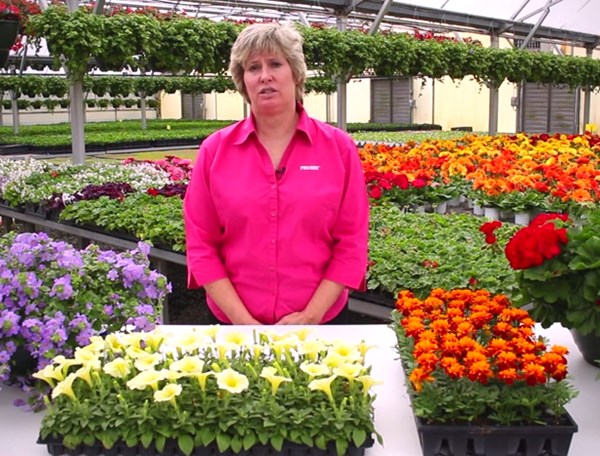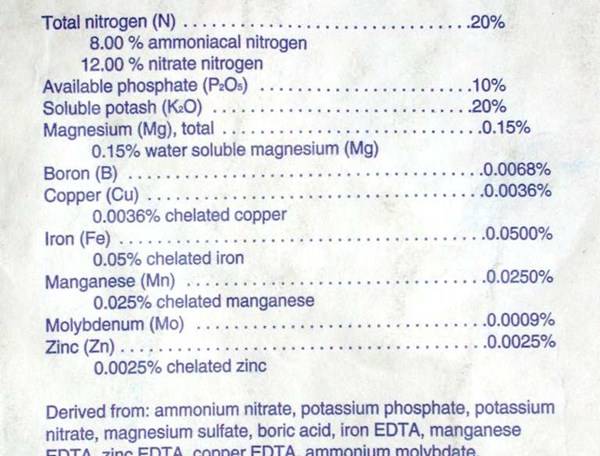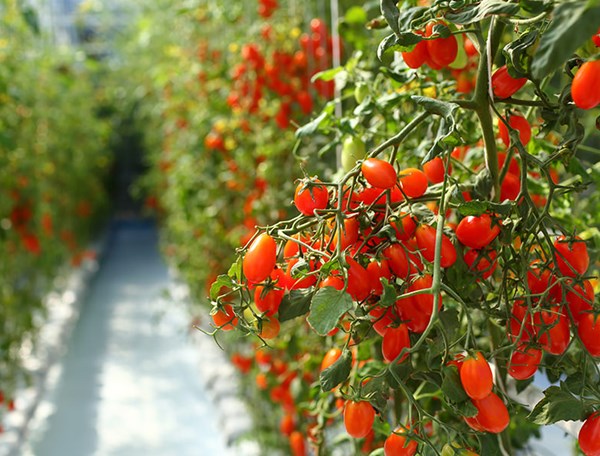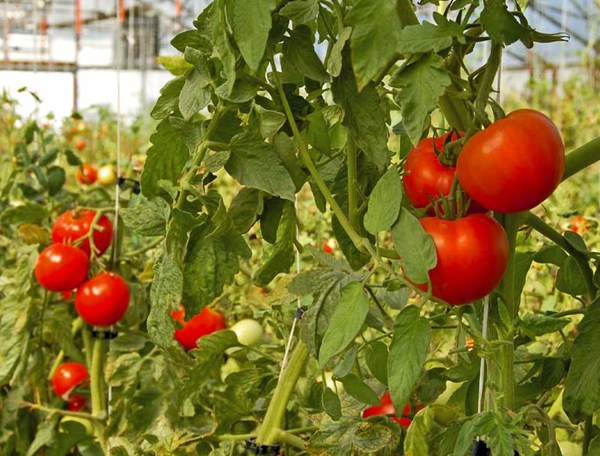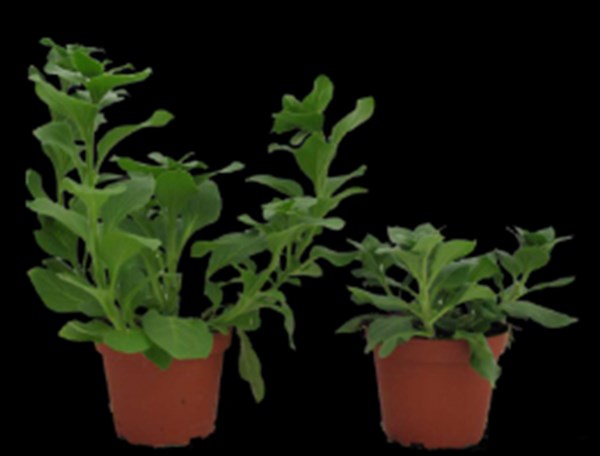Training Center
Relationship Between Fertilizer & Plant Stretching
Thursday, September 7, 2023 | Troy Buechel
The goal of every grower is to produce high quality plants. One of the characteristics of a high quality plant is compact growth with good branching. Plants with these characteristics are stronger and able to withstand shipping and environmental stress. Growth regulators are often used to produce this desired growth, but fertilizer also has an impact on plant stretching and size.
The three main attributes associated with plant stretch from fertilizer are: fertilizer application rate, nitrogen forms and phosphorus.
Fertilizer Application Rates
The more fertilizer a crop receives, the faster it grows. We know if a crop is provided with too little fertilizer, plant growth response is poor; but if fertilizer rates are excessive, plant growth slows and there is a potential for root damage or death from high fertilizer salts. If fertilizer application rates are maintained between these extremes, then plant growth can be manipulated based on the fertilizer application rate.
Plants such as tomatoes respond significantly to small changes in fertilizer application rates. Fertilizing a tomato plant with low fertilizer application rates (50 ppm N) will not only restrict stretching and height, but also restricts leaf size. Nutrient deficiencies can be an issue, but typically crop quality is acceptable. So up to a point, fertilizer can be withheld from a tomato to manipulate plant height and size.
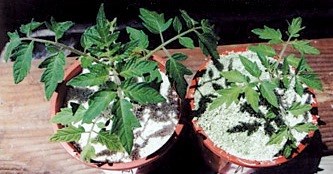
Notice the tomato on the right is smaller due to lower fertilizer application. Crop quality is acceptable, so slightly reducing fertilizer application rate could
be used to control height of tomato plants. Source: www.columbiapublications.com
Vegetative petunias, when fertilized at reduced rates (less than 150 ppm N) also have a reduction in growth, stretching and leaf size, but they easily show nutrient deficiencies, exhibit poor quality, often stop growing and are poorly equipped to handle environmental stress. Keep in mind that while reduced fertilizer application rates decrease the amount of N, P, K, important micronutrients, such as iron and manganese are also significantly reduced affecting plant quality. Although fertilizer application rates can be reduced to control stretching and plant size, crop quality is unacceptable, unlike tomato.
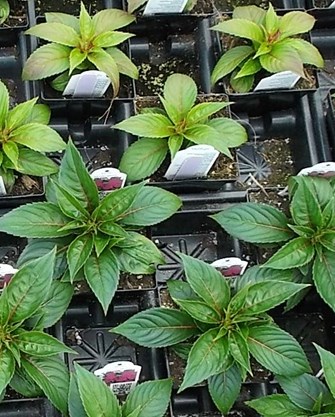
Notice the difference in plant size in the New Guinea impatiens. Plants in the top of the picture are stunted and chlorotic due to reduced fertilizer application, while those in the bottom are larger due to proper fertilizer application. Fertilizing at reduced rates controlled plant growth, but compromised quality.
Reducing fertilizer application rates to regulate plant growth works well, but can easily compromise plant quality. The risk is weighing out the benefits versus the potential loss in crop quality and performance for the end user. Therefore withholding fertilizer is not always the best option for controlling plant height and growth.
Nitrogen Forms
It has been long thought that the form of nitrogen used to fertilize a plant influenced plant stretching and quality. Ammoniacal nitrogen has been thought to cause plant stretching, increase leaf size and produce soft growth; while nitrate nitrogen produces compact, firm growth with smaller leaves. Experientially this seems to be true. For example 20-10-20, which has 40% ammonium and 60% nitrate, can promote stretching, larger leaf size and softer overall growth compared to 13-2-13 which is 6% ammonium and 94% nitrate. However there is another variable; if both fertilizers are applied at the same nitrogen application rate; 20-10-20 provides more than three times as much phosphorus as 13-2-13.
Traditionally fertilizers that have a high ratio of ammoniacal nitrogen also have higher levels of phosphorus due to their formulation with ammonium phosphate. Fertilizers with higher ratios of nitrate usually have little to no phosphorus content since the calcium nitrate they are formulated with can form precipitates with phosphate. So is the nitrogen source the factor in plant stretching?
Dr. Paul V. Nelson, Professor Emeritus of NCSU and his team, conducted research with various bedding plants in which he applied fertilizer with different ratios of ammoniacal to nitrate nitrogen, while keeping all other nutrients the same. The results demonstrated that there was little difference in plant growth. Based on these results, the old idea that ammonium causes plant stretch and nitrate produces short, more tone plants was not true. Dr. Nelson concluded that the form of nitrogen has little influence on plant height and growth.
Phosphorus
Dr. Nelson then looked at phosphorus. In his research, he formulated fertilizers with different levels of phosphorus, but kept the nitrogen ratios and all other nutrients the same. The results showed a significant difference in the height of bedding plants in which those fertilized with a high phosphorus fertilizer were taller than those given a low phosphorus fertilizer. The conclusion was obvious; it is not the form of nitrogen in a fertilizer that influences stretching and plant growth, but it is the amount of phosphorus.
This conclusion makes sense as symptoms of phosphorus deficiency include plant stunting and darkening of the leaves as seen in the following picture. These symptoms are good quality attributes for most plants; however, prolonged phosphorus deficiency can progress into foliar necrosis and deterioration of crop quality. A water soluble fertilizer should provide a minimum phosphorus level (P2O5) of 10-15% of the nitrogen concentration (i.e. fertilizers with analyses such as 20-2-20 or 20-3-20). Some plug crops may prefer higher levels of phosphorus and may benefit from an analysis such as 20-5-20. Fertilizers such as 20-10-20 or 20-20-20 provide more phosphorus than crops need, but other than plants being taller; these fertilizers do not have a negative impact on crops.
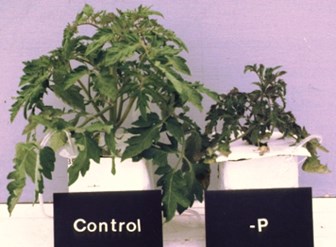
Notice the impact of phosphorus on tomato growth. The plant on the left is grown with normal levels of phosphorus, while the one on the right is shorter and smaller due to phosphorus deficiency. Source: apps.cdfa.ca.gov/frep/docs/Tomato.html, Jim Richards, UC Davis.
Conclusion
Overall, we can see manipulation of fertilizer can influence plant height and crop growth. The old adage that ammonium stretches plants and nitrate leads to compact growth is not as significant as once thought; in fact, these nutrients do not seem to manipulate crop growth much at all. Reducing fertilizer application rates can help, but often compromise crop quality and end user satisfaction. The one variable that can reduce plant stretching without compromising crop quality is reduction of phosphorus application rates.
For more information, please contact your fertilizer manufacturer or your Premier Tech Grower Services Representative.
 |
 |
 |
 |
|---|---|---|---|
|
Ed Bloodnick |
Nathan Wallace-Springer |
Lance Lawson |
Victor Brantly |
 |
 |
 |
|
|
Troy Buechel |
Susan Parent |
Jose Chen Lopez |
PRO-MIX® is a registered trademark of PREMIER HORTICULTURE Ltd.
Related Articles
-
Influence of Fertilizer on Growing Media
Horticulture Specialist from our Grower Services team, JoAnn Peery, explains the 2 main factors to determine the fertilizer you should use depending on your water quality and the kind of crops you are growing.
-
Fertilizers are necessary to feed plants with nutrients that are not available in the growing medium solution or the irrigation water.
-
Ideal Fertilization for Greenhouse Vegetables and Herbs
Vegetables and herbs fertilization requirements are similar to bedding plants early in their crop cycle. However, as vegetable and herb plants progress from vegetative growth into flowering and fruit production, fertility rates and ratios change for each crop.
-
Organic Fertilizers for Crop Production
As greenhouse organic methods of plant production have increased in interest, the need for viable organic fertilizers has also increased.
-
DIF For Control of Plant Stretching on Bedding Plants, Ornementals and Transplants
Having a high tech greenhouse gives the grower total control over environmental parameters including temperature, light, relative humidity and CO2 and also the root zone environment.

 Where to find our products
Where to find our products
